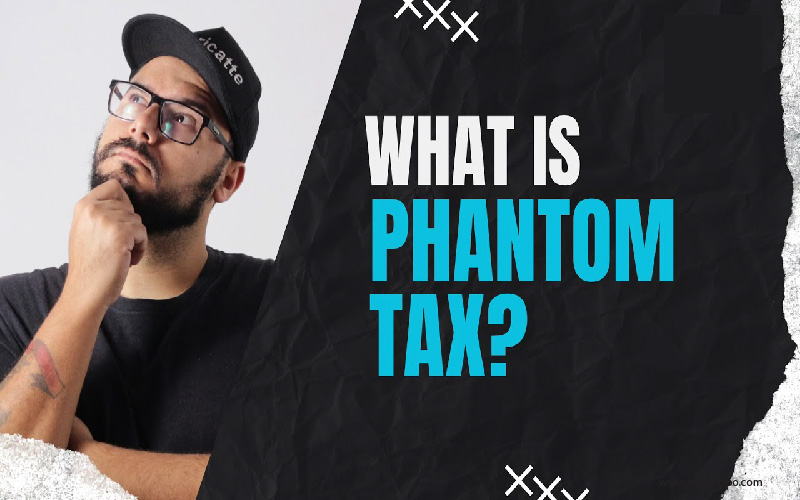Demystifying Phantom Tax: How to Understand and Manage Hidden Taxes
Are hidden taxes lurking in the shadows of your finances, ready to strike when you least expect it? Phantom Tax, the mysterious villain of the financial world, can wreak havoc on both individuals and businesses. In this blog post, we will shine a light on this elusive foe, uncovering its secrets and providing you with strategies to outsmart it. Get ready to demystify Phantom Tax and take control of your financial destiny!

Understanding Phantom Tax
Phantom Tax, the stealthy specter of the tax realm, is not your typical income or sales tax that you see coming from a mile away. It operates in the shadows, disguised within complex financial transactions and overlooked loopholes. Understanding Phantom Tax requires peeling back the layers of ambiguity to reveal its true nature – a sneaky way for the government to snatch a portion of your hard-earned money without you even realizing it.
Unlike traditional taxes that are straightforward and transparent, Phantom Tax hides beneath the surface, waiting to surprise unsuspecting taxpayers with unexpected liabilities. To combat this elusive enemy effectively, individuals and businesses must arm themselves with knowledge and vigilance. By shedding light on this enigmatic phenomenon, we empower ourselves to navigate the intricate maze of hidden taxes and emerge victorious in our quest for financial freedom.
Types of Hidden Taxes
Hidden taxes come in various forms, lurking beneath the surface of our financial transactions. One common type is known as “sin taxes,” which target products like alcohol, tobacco, and sugary beverages to deter consumption while generating revenue for the government. Another sneaky tax is the “inflation tax,” where the value of money decreases over time due to rising prices, effectively reducing purchasing power.
Property taxes can also be considered hidden, as they are often overlooked until it’s time to pay up at the end of the year. Transaction fees imposed by banks or credit card companies may seem small individually but can add up significantly over time. Additionally, tariffs on imported goods can indirectly impact consumers by raising prices on products we use daily.
It’s essential to stay informed about these different types of hidden taxes to better understand their implications on your finances and make informed decisions moving forward.
How to Identify Hidden Taxes
When it comes to identifying hidden taxes, being vigilant and thorough is key. Start by reviewing your financial statements with a keen eye for any unusual or unexpected charges that could indicate the presence of phantom taxes. Look out for terms like “fees,” “surcharges,” or “assessments” that may camouflage hidden tax implications.
Consulting with a tax professional can provide valuable insights into areas where hidden taxes might be lurking. They have the expertise to uncover subtle tax obligations that you may have overlooked on your own. Additionally, staying informed about changes in tax laws and regulations can help you stay ahead of potential phantom tax traps.
Keep track of possible indirect taxes imposed on goods or services you use regularly. These indirect taxes often go unnoticed but can add up significantly over time if left unchecked. By staying proactive and attentive, you can better identify and address hidden taxes before they negatively impact your finances.
The Impact of Phantom Tax on Individuals and Businesses
Phantom Tax can have a significant impact on both individuals and businesses, lurking in the shadows and silently eroding financial resources. For individual taxpayers, hidden taxes can manifest in various forms, such as inflation-induced tax bracket creep or stealth taxes embedded within consumer goods and services.
These unseen tax burdens may reduce disposable income, limit savings potential, or even lead to unexpected tax liabilities come filing season. Businesses also face the brunt of phantom taxes through complex regulations, compliance costs, and indirect taxation that often go unnoticed until profits are affected.
The subtle nature of phantom taxes can distort economic decisions, hinder growth opportunities, and create an atmosphere of uncertainty for both individuals and businesses alike. It is crucial to shed light on these hidden levies to better understand their implications and take proactive measures to mitigate their adverse effects.

Strategies to Avoid or Mitigate Phantom Tax
When it comes to navigating the complexities of phantom tax, having a proactive approach is key. One strategy to mitigate hidden taxes is proper tax planning. By staying informed about potential tax implications and seeking professional advice, individuals and businesses can identify opportunities for savings and minimize their tax burden.
Another effective strategy is to keep detailed records of financial transactions. Maintaining accurate documentation can help uncover any hidden taxes that might otherwise go unnoticed. Additionally, exploring tax-efficient investment options and retirement accounts can also be beneficial in reducing phantom tax liabilities.
Furthermore, considering the timing of financial decisions can play a significant role in managing hidden taxes. By strategically timing income recognition or deductions, taxpayers may be able to optimize their tax position and avoid unnecessary phantom taxes. Being proactive and vigilant in your approach to taxation can help you navigate the complex landscape of hidden taxes effectively.
Common Mistakes to Avoid When Dealing with Hidden Taxes
When it comes to managing hidden taxes, there are some common pitfalls that individuals and businesses should steer clear of. One frequent mistake is overlooking tax implications when making financial decisions. Failing to consider the potential tax consequences can lead to unexpected liabilities down the road.
Another error is neglecting to stay informed about changes in tax laws and regulations. Tax rules can evolve, impacting how hidden taxes may affect your finances. It’s crucial to stay up-to-date on these developments to avoid any surprises.
Additionally, not seeking professional advice can be a costly misstep. Tax professionals can provide valuable insights and guidance on managing hidden taxes effectively. Relying solely on guesswork or outdated information may result in missed opportunities for tax optimization.
Procrastination in addressing hidden taxes can compound the issue over time. Being proactive and tackling potential phantom tax implications promptly is key to avoiding unnecessary financial burdens later on.
Conclusion: Take Control of Your Finances by Tackling Phantom Tax!
Take control of your finances by understanding and managing phantom tax. By being aware of the various types of hidden taxes, you can identify them early on and lessen their impact on your financial well-being. Implementing strategies to avoid or mitigate these unseen taxes can help protect both individuals and businesses from unexpected expenses. Remember to steer clear of common mistakes when dealing with hidden taxes to ensure a smoother financial journey.
Empower yourself by demystifying phantom tax. Stay informed, stay vigilant, and take proactive steps towards securing your financial future in the face of these elusive levies. By mastering the art of navigating hidden taxes, you can safeguard your hard-earned money and pave the way for a more stable and prosperous financial path ahead.